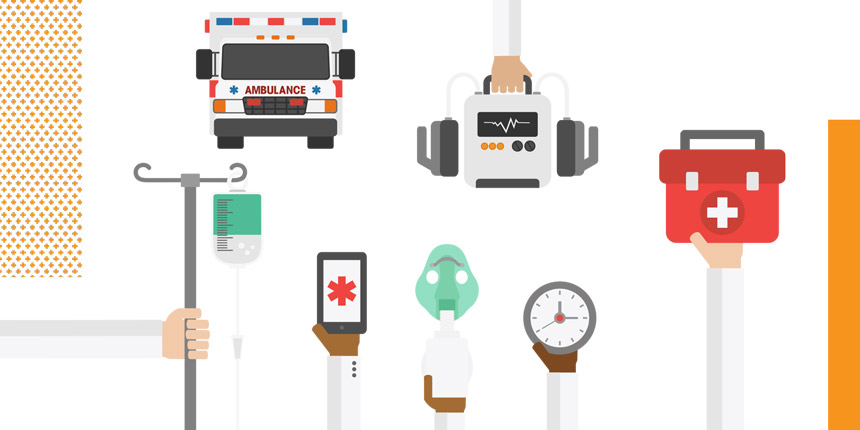Health+
New Level II Trauma Center Will Fill a Critical Need

Southcoast Health is building a Level II trauma center at St. Luke’s Hospital
Victims of traumatic injuries are in a race against time. Whether a person experiences a blunt force injury (when an object or force strikes the body, often causing concussions or broken bones) or a penetrating wound (when an object pierces the skin), a trauma patient needs specialized medical attention within an hour for the best outcome.
Providing specialized care close to home is the motivation behind St. Luke’s Hospital’s new Level II trauma center, expected to open in 2020. The center will be the first of its kind in the region, serving southeastern Massachusetts and parts of Rhode Island.
“When a hospital commits to being a trauma center, it tells you that the hospital is making a commitment to being completely full-service,” says Dr. Michael Grossman, Chief of Trauma Surgery at Southcoast Health.
What Is a Trauma Center?
A trauma center is staffed 24-7 with in-house neurosurgeons, orthopedic surgeons and plastic surgeons, among other specialists. “But what distinguishes a trauma center is those services are immediately available within a timeframe that is governed by the requirements for trauma center verification,” says Dr. Grossman, who is managing the development of this center and previously set up trauma centers in New York and Pennsylvania. “Similar to other hospitals, we have intensive care units, but our ICUs will have specific capabilities focused on the care of trauma patients.”
A Level II trauma center is equipped to see any type of trauma patient and has the same clinical capabilities as a Level I center. Unlike a Level I center, it is not required to conduct research or have surgical residency programs.
Filling a Trauma Care Void
Currently, there are few trauma centers within an hour drive of New Bedford. And with severe injuries, every second counts.
“Trauma patients need immediate intervention,” says Stephanie Raby, Trauma Program Manager at Southcoast Health. “You need to be seen within an hour by a trauma surgeon to interrupt any traumatic bleeding that’s occurring.”
Traumatic injuries are the leading cause of death for individuals up to 45 years old, according to the American Association for the Surgery of Trauma. The biggest risk, as noted by Raby, is the blood loss caused by common traumatic events, such as car accidents, falls and shootings.
“It’s the internal bleeding process that the trauma surgeons are really here to address,” Raby says. “They have the capability to rapidly assess the patient and stop the bleeding. If there’s bleeding in the brain, for example, you need to relieve that intracranial pressure very quickly.”
Based on an analysis of the area’s need, St. Luke’s Hospital anticipates that it will handle a volume of 1,000 trauma patients a year. But access to immediate care is just the beginning.
The journey to recovery for many trauma patients includes hospital stays, surgeries and rehabilitative treatments. Before joining Southcoast Health, Raby played a key role in setting up Pomona Valley Hospital’s Level II trauma center in the Los Angeles area, and she observed the significance of having a local presence. “Trauma is typically unexpected,” she says. “When someone experiences a head injury or has broken bones, it can take months for them to recover. We don’t want our patients to have to travel far away to do that. Southcoast has stepped up to the plate to provide that service here in this underserved community.”
No Small Task
Becoming a Level II trauma center is a rigorous process that involves verification by the American College of Surgeons, as well as submitting data on the treatment of trauma patients to the National Trauma Data Bank and Massachusetts Department of Public Health to achieve verification.
Dr. Grossman and Raby are leading the charge, which has many moving parts. They are hiring trauma center staff, including surgeons, nurses, critical care personnel and trauma registrars. They are also writing policies and procedures, and will undertake training the new staff. At the same time, the hospital is remodeling to expand the trauma bay and create more space for operating rooms and critical care beds.
“We also need to order new equipment and supplies,” Raby says. “The blood bank needs to be prepared for more transfusions, and our operating rooms need to be prepared 24 hours a day, seven days a week.”
A process like this would typically take 18 months to two years, but Dr. Grossman plans to get there sooner. “We’re hopeful that we can begin the process of pursuing verification within a year,” he says. “Stephanie and I have both done this before, and although we think that it’s a pretty aggressive timeline, we do think it’s realistic.”
The Emergency Departments at Charlton Memorial, St. Luke’s and Tobey Hospitals can treat all kinds of sudden and severe illnesses and injuries. St. Luke’s ED even has pediatric specialists from Boston Children’s Hospital on site around the clock who also are available to consult on pediatric patients at Charlton Memorial and Tobey.
